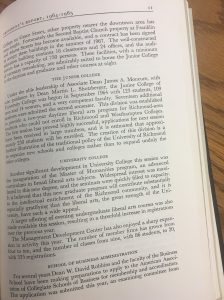By Jennifer Munnings
 The 1964-1965 President’s Report highlights the first year of the Junior College’s establishment under University College. University College was formed in 1961, and the intention to develop the Junior College was expressed the same year by the Board of Trustees. Given that the Board of Trustees minutes are sealed indefinitely, the true intention behind the formation of University College and the Junior College is based on educated guesses, and published documents. The President’s Report report says on the formation of the Junior College: “This division was established to provide a two-year daytime liberal arts program for Richmond-area students who could not enroll in Richmond and Westhampton Colleges.” Historical context suggests that part of the reason University College and subsequently the Junior College were instituted was as a means to continue to receive federal funding without integrating the main campus.
The 1964-1965 President’s Report highlights the first year of the Junior College’s establishment under University College. University College was formed in 1961, and the intention to develop the Junior College was expressed the same year by the Board of Trustees. Given that the Board of Trustees minutes are sealed indefinitely, the true intention behind the formation of University College and the Junior College is based on educated guesses, and published documents. The President’s Report report says on the formation of the Junior College: “This division was established to provide a two-year daytime liberal arts program for Richmond-area students who could not enroll in Richmond and Westhampton Colleges.” Historical context suggests that part of the reason University College and subsequently the Junior College were instituted was as a means to continue to receive federal funding without integrating the main campus.
Although the 1954 Supreme Court case Brown v. Board of Education was targeted at public institutions, private universities, like University of Richmond, that resisted integration were in danger of losing funding and being penalized. The University’s failure to desegregate resulted in the centering of the T. C. Williams School of Law by the Association of American Law Schools. On June 8th 1964 Walter Carpenter became the first black man to graduate from University College although University of Richmond had not announced that it would integrate until that same semester. There were also twelve black students whose names are unknown that were enrolled in night courses. So, what prompted the public announcement of its integration? And, who are the populations that Richmond and Westhampton College cannot serve?
The same year the Civil Rights Act of 1964 was passed and University of Richmond–having previously been chastised for its slow integration process–wanted to ensure that federal funding was not threatened with a public statement affirming its acceptance of black students. The public announcement was necessary as Richmond city and the state of Virginia were in an era of massive resistance to desegregation. So, people that were refused by the main campus attended University College or the Junior College, schools that were still under development. The report highlights that the Master of Humanities program was implemented to University College three years after the college had been open. Additionally a large part of the faculty hired to work at the two institutions were part-time employees.
University of Richmond’s main campus had students of color on campus prior to the 1960’s, just not black students up until 1968 with the arrival of Barry Greene. So, the population that University College and the Junior College were intended to serve were black, and low income people. The report says, “The creation of this division is a further illustration of the traditional policy of the University of Richmond to organize new schools and colleges rather than expand unduly the older colleges.” University of Richmond relocated several times to accommodate its growing and changing populations, this history was convenient for them in finding ways to justify creating a new branch of the University instead of simply integrating. Additionally, the University was not known for being progressive, and sticking to tradition was something the school prided itself on. Although the establishment of University College and the Junior College can be seen as the University of Richmond attempting to establish itself within the Richmond community, it was also a strategic move to delay integration.
Jennifer Munnings is a sophomore, intending to major in Sociology with a minor in Women, Gender, and Sexuality Studies. Jennifer is new to the Race & Racism Project, joining in Summer 2017 as a summer fellow.
